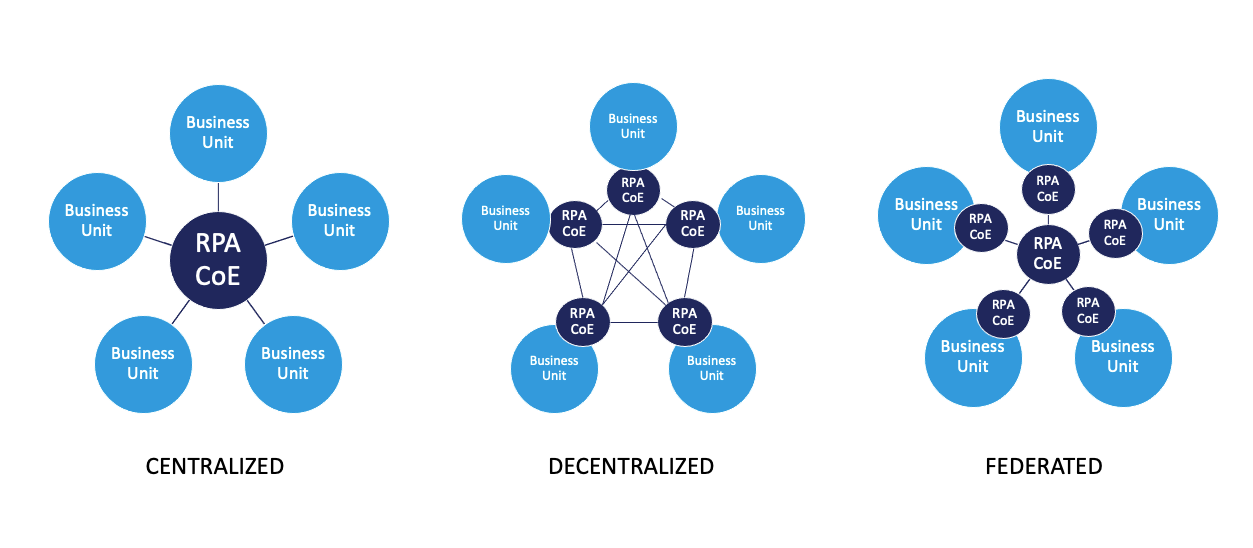How to Improve RPA Centers of Excellence (CoE)
Setting up an RPA (robotic process automation) Center of Excellence (CoE) to govern, standardize, and optimize your automation practice is a step in the right direction.
Like anything else in software development, getting an RPA CoE off the ground shouldn’t be a “set it and forget it” process. To ensure you’re getting the most out of your RPA CoE, you want to continuously analyze and evaluate it. Making tweaks to your Automation Center of Excellence where needed is a best practice.
When looking for ways to improve the performance and impact of your CoE, here are some areas to look at and tips for improvement that you can easily apply.
#1 – Change your governance model if things aren’t working
When organizations initially implement an RPA Center of Excellence, it usually takes the form of a centralized model. A single, small team is responsible for an entire organization’s automation practice from identification to delivery and monitoring.
As a company’s RPA program scales, a centralized model for a CoE might not be effective. The volume of automation candidates and requests coming from other business units or departments may be too much to manage.
If scale is causing bottlenecks or throttling your automation output, that might suggest it’s time to change your governance model and establish a decentralized or federated RPA CoE.
In a decentralized model, each business unit or department has its own RPA Center of Excellence embedded in it, and all CoEs collaborate to maintain best practices and organizational standards.
In a federated model, multiple smaller RPA CoEs are established to represent various departments or business units. However, they all are managed by one central RPA Center of Excellence.

#2 – Promote automation evangelism
One issue that could be negatively impacting your RPA Center of Excellence is employee resistance to automation or the lack of awareness that your organization has an RPA CoE or even an automation program.
There is a perception that cost-reducing automations are achieved by reducing your headcount. That theory has repeatedly been debunked as automation has been shown to deliver cost reduction by eliminating human error in process execution and being able to execute processes 24/7 instead of being tied to traditional business hours.
A solution to that misconception and the challenges it poses is promoting automation evangelism within the RPA CoE and your executive sponsors. Part of evangelizing automation within an organization is advocating the reality that RPA removes the responsibility of carrying out mundane, swivel-chair business tasks so employees can focus on more critical, thoughtful business projects and objectives.
An automation evangelist promotes the idea that RPA improves an employee’s day-to-day workload and experience. When successful, evangelists help to remove the barriers muting automation requests and find that the demand to automate more processes across the breadth of an organization significantly and steadily increases.
#3 – Become more agile
Ideally, an RPA Center of Excellence should be functioning within the agile methodology for software development. If over-flowing automation backlogs and stifled delivery times are something your CoE is dealing with, the origin could be the way you’re managing work.
Applying an agile approach to RPA design and delivery is more than just setting up a dedicated team to manage automation design, delivery, and maintenance. Key agile principles like sprint planning to strategically manage and prioritize work with retrospectives to identify and bake in learning are also needed.
Learn More: How an Agile Approach to Automation Can Deliver RPA at Scale
#4 – Expand automation beyond just RPA
It’s a very common trap to become over-reliant and solely focused on RPA as the lone automation mechanism. To really turbo-charge ROI from automation, many CoEs are coming to the same conclusion: automation needs to expand past just RPA onto other automation alternatives.
As more and more organizations are leaving their legacy RPA platforms for Microsoft Power Automate, they’re embracing the entirety of the Power Platform to find more suitable automation use cases for their business needs.
For example, with Power Automate being used with the Dataverse as its data source, automated virtual agents can be built with Power Virtual agent, business applications can be easily created with Power Apps, and reporting can be consolidated and automated with Power BI.
As a low-code platform, scale is inevitable with the Power Platform as citizen developers can be empowered to deliver automation opportunities with your RPA CoE’s oversight, or delivery is simply accelerated due to ease of use.
Just like any other type of software development, your RPA practice should always be assessed with the objective of finding ways to improve performance and returns. When examining your RPA Center of Excellence for optimization opportunities, these are the 4 areas or modifications you can make to enhance its impact:
- Consider changing your governance model to a decentralized or federated model
- Invest in automation evangelism across the organization
- Implement an agile approach to your RPA Center of Excellence
- Expand automation beyond just RPA and embrace the Microsoft Power Platform.
Share this
Recent Stories

4 Signs it’s Time to Build an RPA Center of Excellence (CoE)

The Challenges of Implementing RPA Enterprise Software



